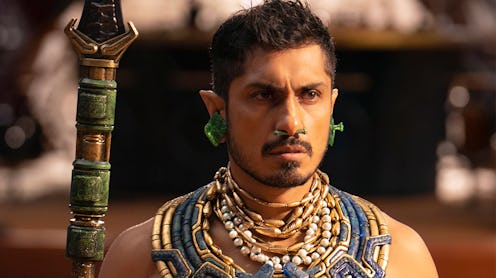TV & Movies
How Marvel’s Namor Is Connected To Kukulkan
Here’s what you missed on your first (or second) watch.

Now that Black Panther: Wakanda Forever is streaming on Disney+, it’s the perfect time to revisit the film’s lore — especially in regards to its complicated new antagonist, Namor. While Tenoch Huerta’s character is mainly credited as Namor, he is also called another name by his soldiers and the local Yucatán people: Kukulkan, the feathered serpent god from Mayan mythology. Interestingly, though, that’s not the case in the comics — so how did Namor come to be known as Kukulkan in the Black Panther sequel?
According to Yucatán Today, Kukulkan’s place among the Mayan pantheon is akin to Jupiter or Zeus’ spot in the Roman/Greek one. That is, he’s a pretty big deal. “In fact, all three are considered the gods of the sky; not the atmospheric sky, but the heavenly kingdom,” the outlet explains.
Kukulkan is not necessarily the fighter he’s made out to be in Wakanda Forever, though. Yucatán Today writes that he was more of a “peaceful god, impervious to squabbles.” But he’s indeed known for his ability to control the elements, like water, which is definitely on display in Black Panther: Wakanda Forever.
Interestingly, Kukulkan does appear in the Marvel Comics — but in a much smaller capacity. In 1948’s Namora No. 1, a statue of the serpent god can be seen in a Mayan temple. And later, in an X-Men comic, the spirit of Kukulkan is reincarnated as a villainous treasure hunter named El Tigre.
However, Kukulkan and Namor are not the same person in the Marvel Comics. Rather, Namor is a mutant prince of Atlantis, the fictional underwater city. So, why did Wakanda Forever combine the character of Namor and the real-life deity of Kukulkan?
For the same reason the original Black Panther based the world of Wakanda on real places and people — like how the Dora Milaje were reportedly inspired by the Agojie women of West Africa. In making the first film, director Ryan Coogler told Geek Culture, “we kind of built a language for ourselves and the expectation from the audience that we would take cultural research and representation seriously, that we would do the work to make sure that we weren’t just putting things in there for no reason.” This set the precedent for “pulling things from real cultures and presenting them in a way that was respectful,” the filmmaker added.
Instead of removing the character’s comic book moniker entirely, of course, Wakanda Forever opts to rework its origins. n the movie lore, the character ended up adopting the name “Namor” after a Spanish colonizer called him a “niño sin amor,” or a child without love, as a young boy. Kukulkan took on the tail end of the phrase as a reminder that he, indeed, has “no love for the surface world.”